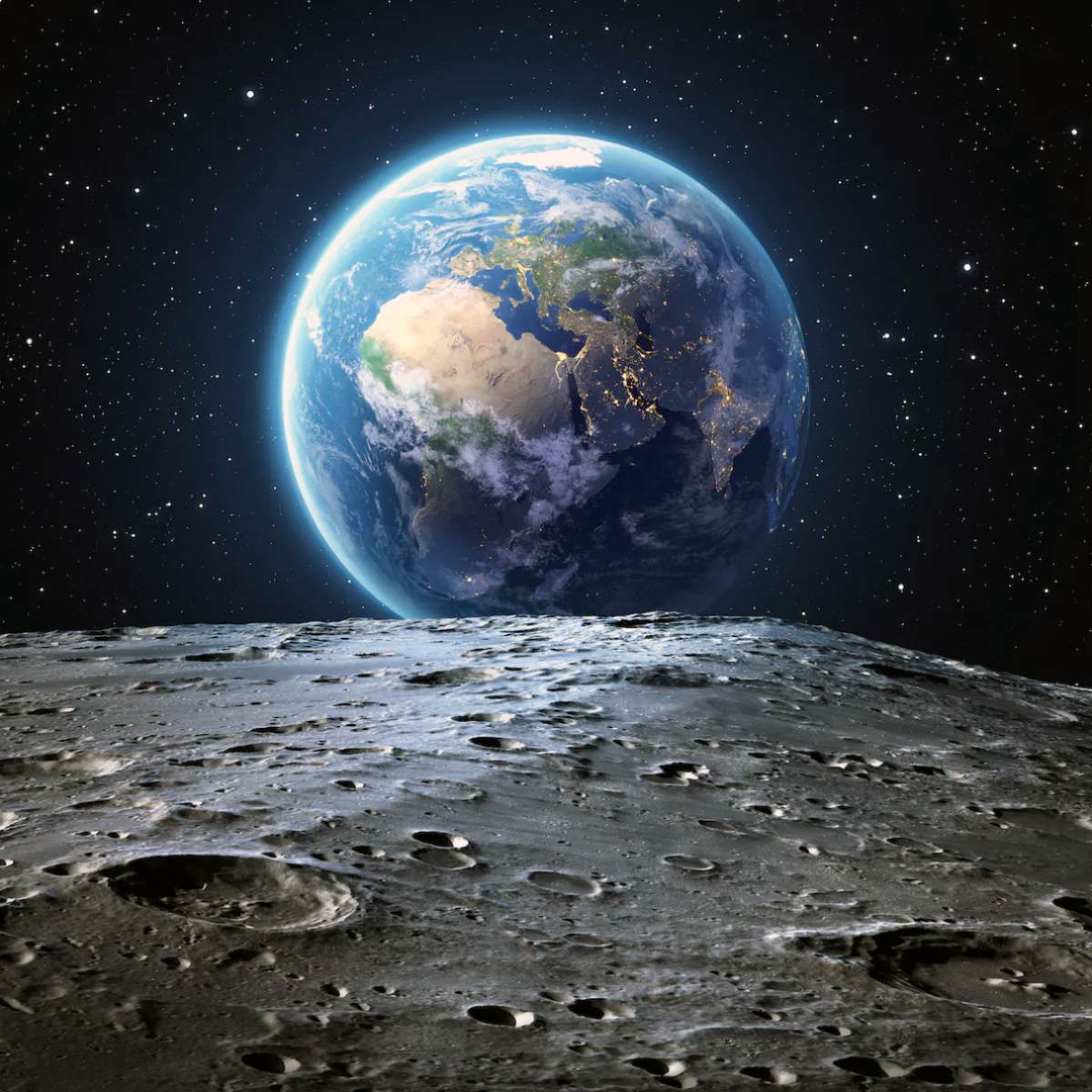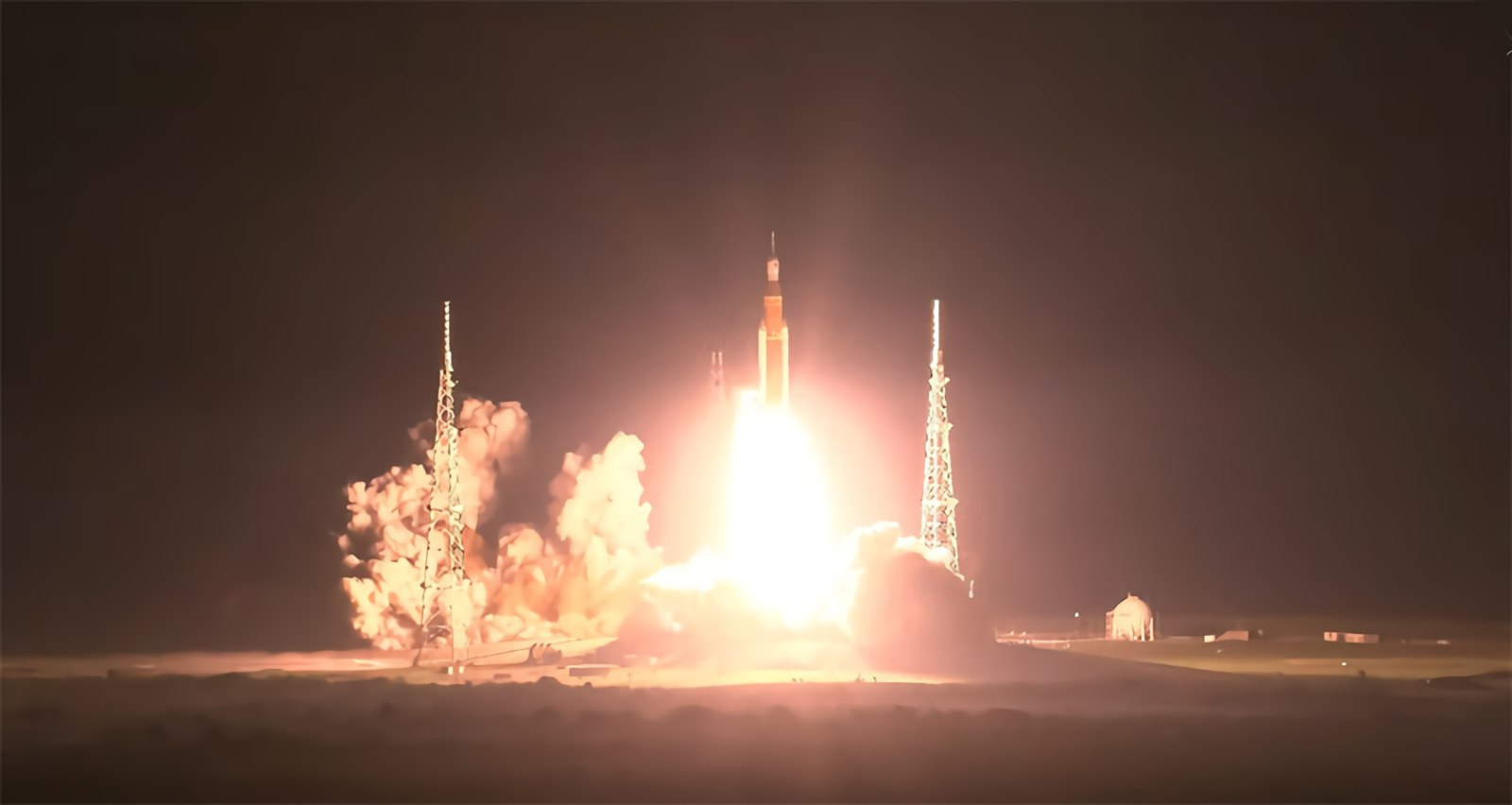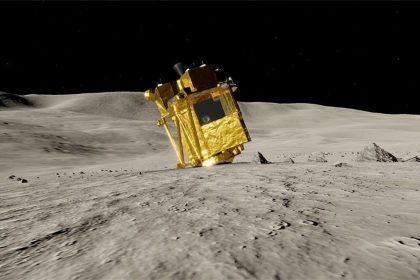They have long existed in science fiction: life-friendly moons around alien planets. And theory also predicts their existence. But reality has lagged behind so far. Only in recent years have astronomers discovered a few candidates for extrasolar moons. This raises the question: where are all the exomoons? And what makes them so difficult to observe?
After all, astronomers have now tracked down two exomoon candidates – massive satellites around large gas giants. But given the thousands of exoplanets and more than 200 moons in our solar system, there should be many more such extrasolar moons. How they form, when they remain stable in their orbits, and when they might be habitable are questions that astronomers have been increasingly investigating recently – with some exciting results…
The location of the countless exomoons in space
In our own solar system, there is no shortage of moons: More than 200 moons orbit the planets of the Sun – only the two innermost planets Mercury and Venus are moonless. Especially the two big gas planets Jupiter and Saturn have a considerable number of moons, which are constantly growing due to new discoveries. Jupiter has 79 moons, and Saturn 82 moons.
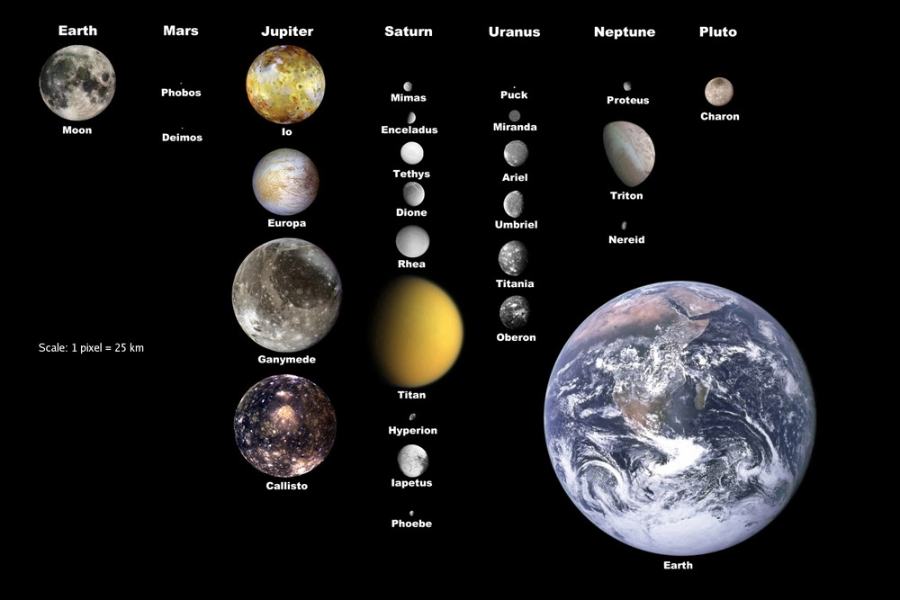
The variety of solar moons is also astonishingly large: Although the Earth’s satellite is today a cold, hull-less world, its presence could have contributed decisively to the development of the Earth and the emergence of life on our planet. In contrast, moons of other solar planets remain fascinatingly complex and dynamic to this day. Jupiter’s moon Io, rolled by the powerful tidal forces of its planet, is the most volcanically active celestial body in the entire solar system, while its nearest neighbor Europa has a liquid ocean beneath its ice crust and is considered the most promising candidate for extraterrestrial life in the solar system.
There are also some dynamic worlds among the moons of the ringed planet Saturn. Enceladus also has a liquid ocean under its crust, and Saturn’s largest moon Titan is even surprisingly Earth-like despite its cold: it has lakes, rivers, dunes and mountains, and its weather knows storms, rain and snow. However, on Titan, icy hydrocarbons rain down from the haze-shrouded sky, and liquid methane and ethane also flow in the waters.
From science fiction to reality
No wonder that this variety of satellites made science fiction authors dream of moons around extrasolar planets decades ago. In their stories, these exo-moons are often life-friendly worlds orbiting super-earths or large gas planets and offering a home to intelligent inhabitants – whether the moon Endor from “Star Wars,” Pandora from the movie “Avatar” or Andoria from the series “Star Trek.”
But it is also considered almost certain among astronomers that many extrasolar planets have satellites. “Given the large number of moons in our solar system, it’s natural to assume that there are also exomoons around some exoplanets – we just need to find them,” says David Kipping of Columbia University in New York. The U.S. astronomer and his team are among the most active exomoon searchers in the world.
So far, however, the yield has been modest: Although thousands of extrasolar planets are already known, astronomers so far know of less than a handful of potential exomoon candidates. But why? What makes the search for exomoons so difficult?
How to find an exomoon?
When it comes to searching for extrasolar celestial bodies, a simple telescope is not enough – most exoplanets, let alone their moons, are too small, too distant, and heavily outshone by their stars to be directly visible. Astronomers must therefore resort to indirect search methods.
One method is to search for tiny wobbles caused by the gravity of a planet or moon at the central star. These wobbles of the star cause slight shifts in the spectrum of its light, which can be detected with high-resolution spectrographs. Using this analysis of radial velocity, astronomers discovered the first exoplanet in 1995, and the three planets around our nearest neighbor star Proxima Centauri were also detected in this way.
The problem, however, is that the smaller and lighter a planet or moon is, and the farther it is from its star, the smaller is its gravitational influence – and the weaker are the changes in radial velocity. Even planets the size of the Earth are difficult to detect with this method. It is much more difficult with the even more subtle signal of an exomoon. Its effect is so weak that it is lost in the general “noise” of the spectral signal.
Shadows in the light curve
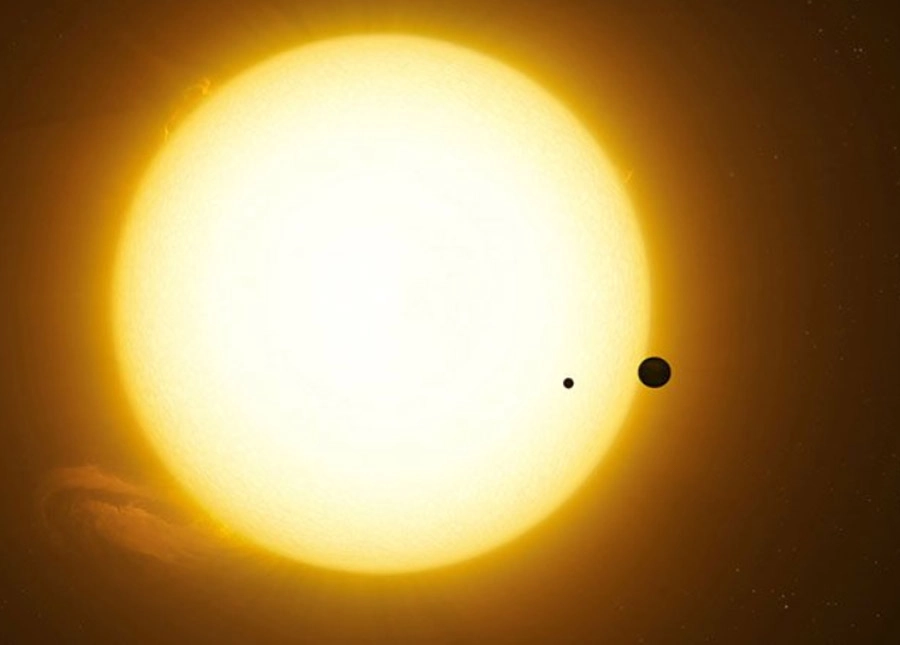
A second search tool is the transit method. In it, astronomers look for the faint dimming of starlight caused by the passage of an orbiting planet directly in front of its star. This transit shows up in a characteristic, periodically recurring dip in the light curve. If this exoplanet has a moon, it will also leave a trace in the light curve.
If the exomoon orbits relatively far from its planet, it ideally appears well before or after its planet in front of the star. This creates a flatter, shorter dent in the light curve that is right next to the larger planetary dent. In 2018, this feature led to the discovery of the first known exomoon, a satellite orbiting a gas giant about 8,000 light-years away.
For their search, U.S. astronomers Aley Teachey and David Kipping tracked the 19-hour transit of the exoplanet Kepler-1625b with the Hubble Space Telescope. They had previously encountered anomalies with this planet in the transit observation data from the Kepler space telescope. “We saw small deviations and fluctuations in the light curve that caught our attention,” Kipping reports.
A first tracking success
The Hubble data confirmed it: There was a small “second dent” in the light curve that occurred 3.5 hours after the shadowing caused by the planet. “This is consistent with a moon that follows its planet like a dog on a leash,” Kipping said. And there was a second indication in the Hubble light curve: Kepler 1625b began its transit nearly 78 minutes earlier than would be expected based on its orbit.
Such so-called Transit Timing Variations (TTV) are also among the signs by which exomoons can be discovered. That’s because they occur because the moon’s gravity pulls on the planet, slowing it down slightly or accelerating it, depending on the moon’s position. “If an extraterrestrial civilization were to observe the transit of the Earth and Moon in front of the Sun, they would see similar anomalies in the Earth’s transit times,” Kipping explains. At Kepler-1625b, the planet began its transit 1.25 hours earlier than it should – another indication of a satellite.
In January 2022, Kipping and his colleagues made their second find: After targeted re-analysis of Kepler data, they came across eleven potential exomoon candidates, one of which proved particularly persistent: “It’s a very robust signal – we put it through its paces, but it didn’t go away,” Kipping says. Dubbed Kepler-1708b-i, the exomoon is the satellite of an exoplanet some 5,500 light-years away.
How is an exomoon formed?
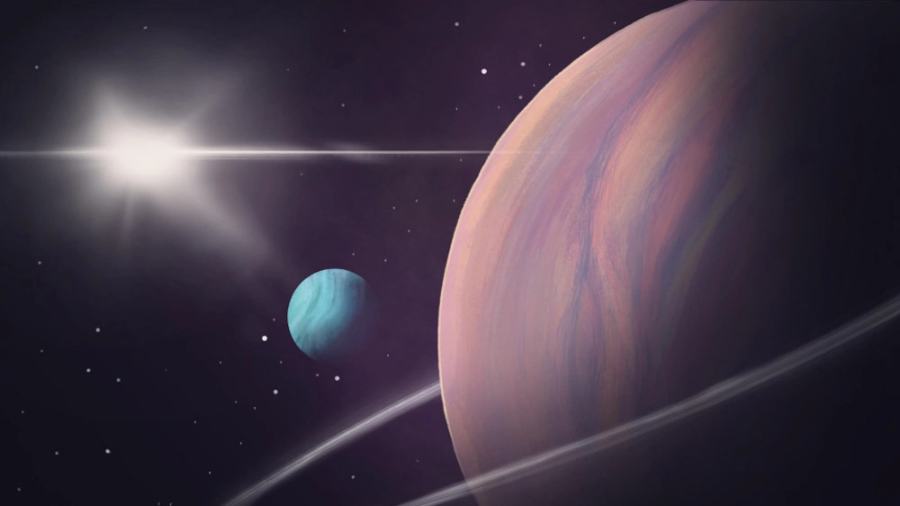
Which planets are the most likely hosts of one or more moons? And how are exomoons formed? Already in our solar system there is no simple answer to this question. Because their formation histories are as diverse as the moons themselves. Nevertheless, they can tell us something about where exomoons are most likely to be found.
Grown from dust and gas
In our solar system, the planets with the most moons are the large gas giants beyond the asteroid belt. Jupiter and Saturn are massive enough to bind whole courts of moons to themselves by their gravitational pull. According to common theory, these moons were formed from dust and rock fragments that orbited these planets in the early days of the solar system and then slowly grew into larger celestial bodies. In the case of Saturn small new moons could develop in the rings even today.
For this to be possible, the protoplanetary disk around the parent star in this region must already be dense enough to contain enough material for one or more moons in addition to the planet. Because massive stars tend to be able to attract more matter, the chance for exomoons around red dwarfs should be lower than around sunlike or even heavier stars. In addition, moons around more massive planets are more likely than around very small ones because they can pull more of these protoplanetary remnants into their orbits.
In fact, astronomers discovered a possible nursery of exomoons for the first time a few years ago. It lies around one of the two young planets of the star PDC-70, about 400 light-years away, a star slightly lighter than the Sun and still surrounded by its protoplanetary dust disk. Images from the Atacama Large Millimeter/submillimeter Array (ALMA) in Chile revealed that the outer planet PDS-70c is surrounded by an extended and massive circumplanetary dust disk. This could contain enough material to form three Earth’s Moon-sized satellites.
Captured and held
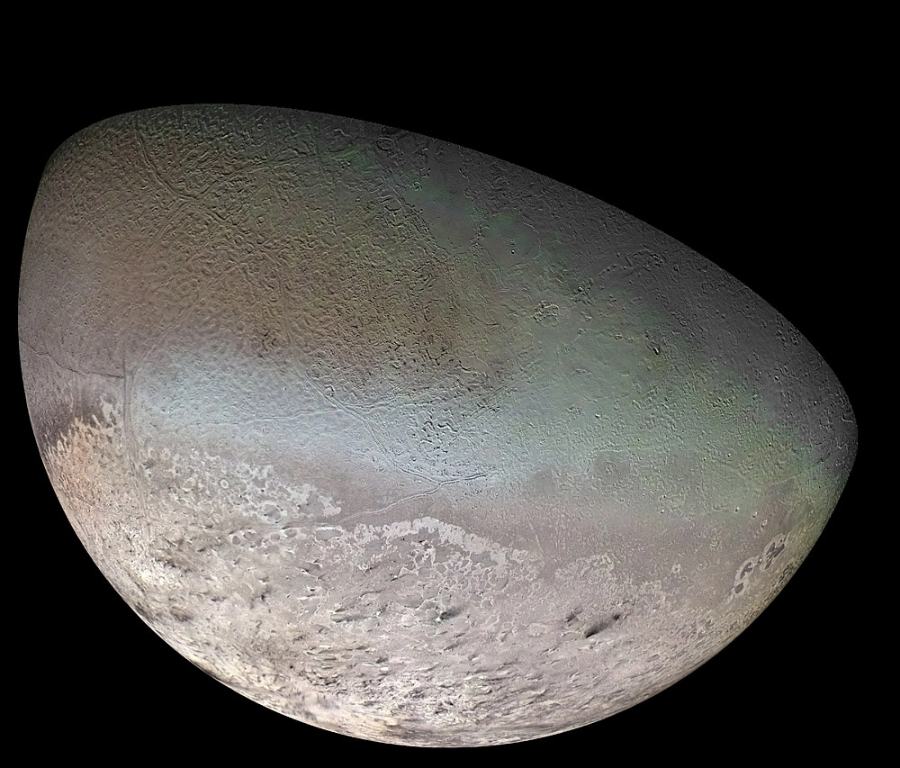
(Credit: NASA)
The second way a planet can acquire a moon is by capture. For example, Saturn’s moon Phoebe and Mars’ moon Phobos may once have been asteroids held in place by the gravity of their planets. The largest example of such a captured moon, however, is Neptune’s moon Triton. Its retrograde, inclined orbit and its resemblance to the icy chunks of the Kuiper belt suggest that this moon was once one of the transneptunian objects and then captured by Neptune.
Astronomers assume similar for the exomoon Kepler-1625b-i. Accordingly, this Neptune-sized giant moon may have originally been the core of a nascent protoplanet in the system around its star. However, the gravity of its larger neighbor Kelper-1625b pulled this planetary seed toward itself, making it a satellite before it had a chance to pull gas toward itself and become a gas giant itself. “The radius and mass of this exomoon are consistent with the characteristics of the planetary core of a gas giant,” explains Bradley Hansen of the University of California at Los Angeles.
Formed from collision debris
And there is a third scenario. Our Earth’s moon owes its existence to it. It was formed when the Mars-sized protoplanet Theia collided with the young Earth, nearly destroying both. A part of the evaporated rock was attracted by the still intact earth core and regenerated our planet, the rest condensed out and formed first a debris ring and the earth, then from this the moon was formed.
Also formed from collision debris is probably Saturn’s moon Hippocamp, which is only 34 kilometers small. This orbits so close to the large inner moon Proteus that it was probably formed from debris from a huge impact on this neighboring moon. Astronomers suspect that this collision ejected large amounts of rock debris, providing raw material for little Hippocamp.
But no matter how a moon was formed, whether it will last depends on another condition.
What makes an exomoon stable?
The only two halfway confirmed exomoon candidates have one thing in common: Not only do they both orbit large gas giants and are themselves quite heavyweights – their planets are also at a relatively large distance from their star. And this is probably no coincidence. For a moon to remain stable in its orbit, it must move between two tightly defined boundaries. And where these lie depends on both the planet’s mass and its proximity to the star.
Keeping distance is advisable
The first limit is set by the planet: its gravity keeps the moon firmly in its orbit as long as planetary gravitational attraction and the centrifugal force of the orbiting moon balance each other out. If the moon orbits too far out, it can easily be flung away by external perturbations; if, on the other hand, it orbits too far in, it is threatened with destruction. This is because the so-called Roche limit marks the range above which the tidal forces caused by the planet are so great that they begin to tear the moon apart.
A moon close to this limit could be the Martian moon Phobos: In its spirally narrowing orbit, it has already approached the Red Planet to such an extent that Martian gravity is gradually attacking its structural integrity. Astronomers assume that the already rather loose and porous Martian moon could break apart at some point – but this will probably not be the case for several million years. The orbit of Neptune’s moon Triton is also unstable and could bring the icy moon close to the Roche limit in the distant future.
A three-body problem
The second limit is the so-called Hill sphere. It describes the range up to which a planet’s arresting gravity outweighs the gravity of its star. If a moon moves at the outer boundary of this sphere, or even beyond it, it can very easily be thrown out of its orbit and flung away. Where the boundary of this Hill sphere lies depends on the mass and distance of the planet and star.
There is hardly any danger with the Earth’s moon: Its orbit, at 380,000 kilometers from the Earth, lies well within the Earth’s Hill sphere, which extends up to 1.5 million kilometers into space. However, the situation is different for the innermost planet in the solar system: Mercury has a Hill sphere of only 200,000 kilometers – there is not much room for a moon between the Roche limit and the Hill radius.
In addition, planets close to the star usually move in bound rotation around their star – they rotate slowly and always turn the same side to the star. This, however, also slows down the motion of moons in their orbit. The gravitational interactions cause a moon to slow down and sink lower and lower around such slowly rotating planets. As a result, sooner or later a moon crashes into its planet or is torn apart at the Roche limit by its tidal forces.
More chances with outer planets
But what does this mean for the search for extrasolar moons? Astronomers investigated this in 2020 using the example of a good 4,000 exoplanets known so far. To do this, they determined the Hill sphere based on planetary and stellar mass as well as the distance between the planet and the star, and then used a model to simulate whether and how long a moon would remain in orbit around such an exoplanet.
It appears that the most important factor in the persistence of an exomoon is the orbit of its planet. For most exoplanets with orbital periods of less than ten days, there is no stable lunar orbit. Then, in the range of ten to 300 days, the survival rate slowly increases from zero to about 70 percent. In other words: If we’re looking for exomoons, we should be targeting mostly massive, far-out orbiting planets – like Kepler-1626b or Kepler-1708b.
Difficult search
The problem, however, is that such planets, which are farther away from their stars, are difficult to observe with conventional methods and even more difficult to examine for moons. This is because the long orbital periods of such planets make transits very rare – catching them is almost a matter of luck. Moreover, these exoplanets are so far away from their star that they make their star “wobble” only very weakly. Measuring the effect of their moons via radial velocity is nearly impossible.
It is therefore no coincidence that the first exomoon candidates are massive giants of several times Earth’s mass: Only their effect was strong enough to be detected by our telescopes. “So the first discoveries are the odd ones out – such giants are the ones that are easiest for us to find,” says U.S. astronomer David Kipping.
That, however, could change with NASA’s new James Webb Space Telescope. That’s because its spectroscopes are so high-resolution that they could detect the signal of even smaller exomoons. “It’s a no-brainer for Webb,” Kipping explains. “It can find extrasolar moons smaller than Jupiter’s moon Europa.”
How life-friendly can an exomoon be?
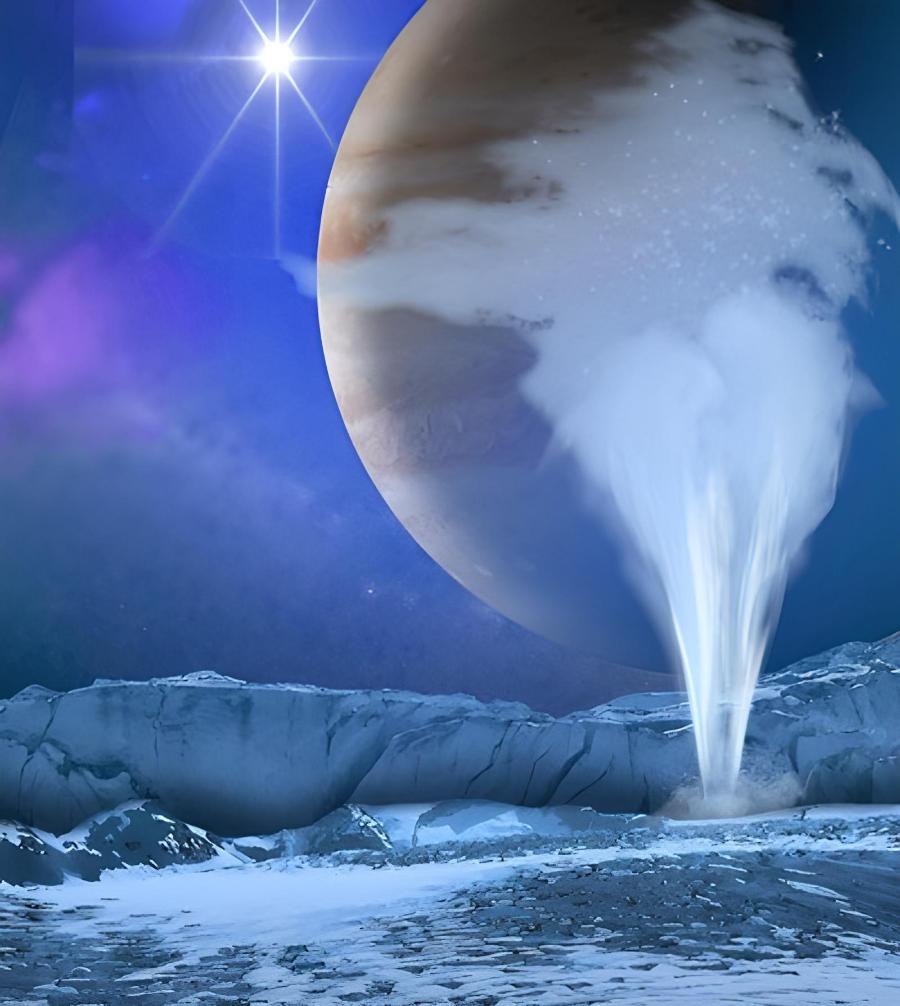
In science fiction, exomoons are often life-friendly, water-rich worlds. But what about in reality? In the solar system, most moons are too far from the Sun and cold to be habitable. And if satellites do indeed form more frequently around gas giants orbiting far out, this could hardly be different in other planetary systems – or could it?
More chances than with an exoplanet
In fact, the chances of habitability are even better for an exomoon than for an exoplanet, as model simulations suggest. Because such a moon is under the influence of both its planet and the star, more factors interact. Such synergistic effects mean that an exomoon can still be warm enough for water and life even outside the habitable zone of its planetary system – because the planet provides the necessary heat.
“Exomoons are more complicated than exoplanets – but that also brings more chances to be life-friendly,” explains Rory Barnes of the University of Washington. A few years ago, the astrobiologist investigated what an exomoon has to bring along to become a life-friendly world – and which factors influence this.
Tidal forces as a heat source
An example of such combined effects: If an exomoon orbits around a gas giant with an orbit similar to Jupiter or Saturn, it would normally be too cold for liquid water – too little radiative heat arrives from the star. But just looking at Jupiter’s moons shows that this need not be an obstacle: The moon Europa has a thick ice crust, but underneath there is a warm, liquid ocean. The source of this warmth is Jupiter’s strong tidal forces, which churn and warm the interior of the moon.
Similarly, tidal forces from exoplanets can also heat their moons, creating their own habitable lunar zone. Scientists can imagine some scenarios where an exomoon becomes habitable just from this tidal heat. However, there is also the flip side: If a planet-moon pair is already orbiting in the star’s habitable zone or at its inner edge, then tidal heating can push the exomoon across that boundary: It then becomes too hot and too volcanic for liquid water and life-like Jupiter’s moon Io.
Not only that, but if tidal forces provide enough heat to keep the exomoon’s interior hot and liquid, they can also give it a magnetic field and plate tectonics. Both occur when there are flows of liquid metal or hot magma inside a celestial body – as is the case with our Earth. Both are also factors that increase the life-friendliness of a celestial body.
Light and shadow from the planet
Besides the tidal effect, an exomoon can also receive additional light and thermal radiation from its planet. This is because, depending on its orbit, the satellite passes through areas where starlight reflected from the planet’s surface falls on it. Such satellites can therefore receive more irradiation than their planets. This also extends the habitable zone for exomoons outward.
Conversely, an exomoon can also be protected and cooled by its planet. This is the case, for example, when it regularly passes through the shadow of a large, nearby planet. This lunar eclipse can significantly affect the climate on the exomoon, astronomers explain. At the same time, this alternation of planetary light and starlight can cause a kind of seasons on the exomoon: Depending on whether there is only one light source in the sky, both, or none, it is winter, summer, or something in between on the lunar surface.
Orbit and size of the satellite are crucial
As astronomers noted, this combination of factors determines the inner limit of the habitable zone of exomoons. If they cross it, tidal forces and irradiation cause the moons to overheat and there is a self-reinforcing greenhouse effect. Outwardly, there is no sharp limit to the distance from the planet. As long as the Hill radius is not exceeded, an exomoon can be habitable far from its planet if the planet orbits in the habitable zone of its star.
Why then, one may ask, do none of the moons around Saturn or Jupiter bear any resemblance to Pandora or Endor? According to astronomers, this could be due to their size: More massive exomoons have a larger habitable zone around their planets than lower-mass ones. For one thing, the inner limit beyond which a moon becomes too warm and unstable is further inward for larger celestial bodies. For another, such moons have enough gravity to hold an atmosphere and thus water vapor and liquid water.
According to the calculations, an exomoon around an extrasolar gas giant would have to be at least the size and mass of the planet Mars to be life-friendly in the longer term. Such a moon would also be massive enough to retain its water as its parent planet migrates inward from the ice-rich outer reaches of its planetary system. An icy moon could then become a water-covered satellite.




